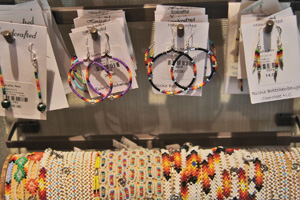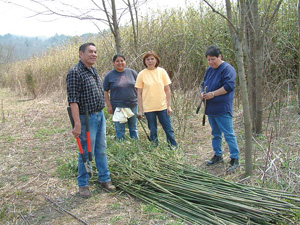Molly Moore | December 21, 2011 | No Comments
By Molly Moore
On the Qualla Boundary, the Eastern Band of Cherokee Indians’ reservation, local resources have inspired arts traditions for generations. Today the community’s rich arts heritage is flourishing.
The town of Cherokee, N.C.,positioned at the southern terminus of the Blue Ridge Parkway and bordering the Great Smoky Mountains National Park, was opened to the tourism economy with the birth of the national park in 1940.



Carved wooden masks by artisans such as Davy Arch are sold at Qualla Arts and Crafts Mutual, Inc. Photos by Molly Moore
With the influx of visitors came a surge of entrepreneurs. At the time, the tribal levy — a business tax — was a main source of revenue for the Eastern Band of Cherokee Indians. The revenue benefited the tribe as well as the artist, but soon outsider-owned businesses flooded the local market with mass-produced goods that promoted disparaging stereotypes drawn from “Cowboy-and-Indian” films.
In response, local artists banded together in 1946 to form the first Native American cooperative, Qualla Arts & Crafts Mutual, Inc. The organization currently has 300 artisan members, and their combined gallery and museum presents a wide variety of goods that blend traditional and contemporary elements.
“We want our artists to grow and try new ways to express themselves,” says Tonya Carroll, Outreach Coordinator at Qualla Arts and Crafts Mutual. “We do want items that incorporate Native American culture but that can be open to interpretation.”
Basketry, mat-making and wood carvings are some of the best-selling items at Qualla Arts and Crafts, but member arts also include beadwork, stone carving, pottery, finger weaving, doll making, painting, drawing, crocheting, shell engraving, wood burning and metal jewelry.
Davy Arch is known for fine wooden masks, but he also carves arrowheads that are available on the lower end of the price spectrum. His mother and grandmothers crafted beadwork, and he can’t remember a time when he didn’t have a carving knife. In his lifetime of involvement in the Cherokee arts community, he’s seen the craft economy shift.
“People used to use the baskets to pick up potatoes and gather corn,” Arch says. “But now [traditional baskets] are high-end collectibles that can sell for thousands of dollars, so you’re not seeing a lot of people out in the potato patch picking up potatoes in their Cherokee baskets. The shift to marketing artwork as a high-end collectible is something that has controlled the way we market things and the product itself.”

Beaded jewelry is just one of the local crafts sold in a gift shop at the casino in Cherokee, N.C. Photo by Molly Moore
The ability to command higher prices has helped these time- and skill-intensive arts survive, but competing with cheap imported goods remains a challenge. Recently, Cherokee artisans have received more support from tribal government and current businesses on the Qualla Boundary. The reservation’s casino is a reliable customer of the Qualla Arts and Crafts Mutual and sells local crafts at casino and hotel gift shops.
“Tribal government is aware that most families have an artist in the family and have a tradition of artwork that links us directly to the past as a culture,” Arch says. “So it’s a concern of the politicians to ensure that there are opportunities for artists.”
The Eastern Band of Cherokee Indians’ Principal Chief Michell Hicks campaigned for Artist’s Row, an outdoor market area near Oconaluftee Islands Park where artists can sign up for space. An attempt by the Tribal Council to pass a resolution that would have required all craft shops on tribal land to sell a certain percentage of local artists’ work did not pass.
Revitalization of traditional artwork has increased demand on the natural resources used in these crafts. To meet that need, the Cherokee Preservation Foundation, which is funded by the tribe’s gaming revenues, established the Revitalization of Traditional Cherokee Artisan Resources program to restore the traditional balance between maintaining and using vital resources.
“Land preservation is a wonderful thing but for us it’s preservation with a purpose,” says David Cozzo, project director for the program. “It’s a living act of management.”
River cane is one such resource. The Cherokee are known for their intricate double-weave baskets crafted from this member of the bamboo family, but not long ago the tribe was down to just two active basket makers. Thanks to a program at the local high school, there are now 15 teens who can make the signature art. But ensuring an adequate supply of river cane is as important to the craft’s survival as the teachers. Fostering river cane stands in the mountainous Qualla Boundary is difficult, particularly since much of the species’ former range has been taken over by agriculture and development.
To find suitable habitat for river cane introduction and management, the revitalization program works with outside groups such as the Land Trust for the Little Tennessee and the Watershed Association of the Tuckaseegee River. Land Trust for the Little Tennessee and Cozzo’s program are planning river cane restoration at Welch Farm, a tract of land that had been used for corn cultivation.

Artisans from the Eastern Band of Cherokee Indians harvest river cane with partner organizations. Photo by Land Trust for Little Tennessee
The resource revitalization program is also working on its first project with the U.S. Forest Service. If all goes well, South Carolina’s Sumter National Forest will house 29 acres of river cane, which would make it the largest actively managed cane site in the Southeast.
The butternut tree is another key species, since the bark produces a distinct dark dye. But a fungus has decimated the butternut population, and the tree’s survival is threatened. A partnership with high school students aims to help researchers find ways to select disease-hardy butternut for cultivation.
Organizations are also experimenting with growing white oak for basketry. But recreating traditional environments has its challenges. Because white oaks grown too quickly are too fibrous for weaving, Cherokee artisans prefer white oaks that grow slowly in laurel thickets with acidic soil. The Land Trust for the Little Tennessee, University of Tennessee and the tribe’s resource revitalization program are working to replicate that habitat on available land trust property. So far, the groups have seen mixed results, but recent plantings are still a few years away from harvest. “It takes eight to 10 years to test the idea,” Cozzo says.
Between the efforts of tribal government, schools and non-profit organizations, there is a network of economic and educational support behind traditional Cherokee crafts. With thoughtful management of natural arts resources, young hands will weave these venerable traditions into the future.
Like this content? Subscribe to The Voice email digests